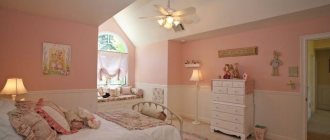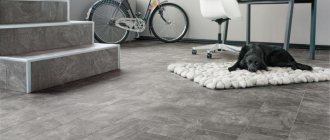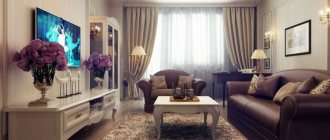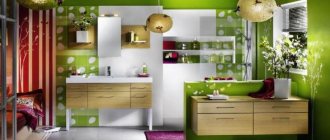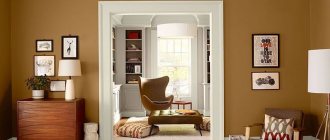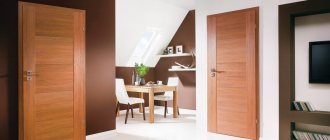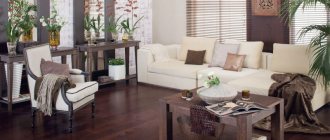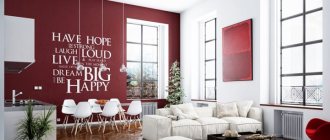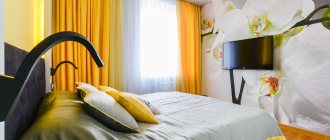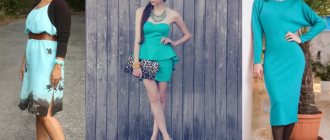Features and influence of wenge color
The color of wenge can be defined as dark brown with black veins, but not everything is so simple. Like any other type of wood, there are variations. Sections are reddish, golden brown, with a slight greenish and purple tint, warmer or cooler.
It’s easier to first understand what wenge is in itself, and only then how to use it in the interior.
Wenge is a tropical tree native to Central Africa, which is a valuable species and grows up to 20 meters in height.
This is a rather rare species, so there is a real hunt for it - and in interiors such decoration is especially valued. The specificity lies in the characteristic cut: it is very decorative, and the veins resemble furrows from the claws of predators.
After cutting, the wenge cut quickly darkens, and the golden wood acquires that same dark chocolate hue. Moreover, the older the tree, the darker its tone.
The expressive texture is difficult to process and cannot be confused with other breeds. Therefore, it appears before designers in all its glory.
Natural wenge wood is heavy, massive, resistant to mold and parasites, and resistant to deformation and bending. But in modern interiors, imitation or laminate are more often used. And in this case, it is especially important to repeat the complex and multifaceted shade in detail.
Combination of wenge color with other shades and textures
In the design concept of a living room, hallway, kitchen or bedroom, this decoration can look different. This color is too ambiguous, and what makes it so is the play of shades.
Combined with different palettes
- An excellent alternative to black, it will soften the contrast in the form of shades of chocolate and milk in a black and white apartment setting.
- Reddish furniture (wenge) in the living room interior goes well with warm colors, which will help “warm up” the room on the north side.
- The rich tones of veined African wood harmonize with the cold palette, perfectly highlighting blue, green and lilac tones. This color scheme is suitable for a bedroom on the south side of the house.
- The classic combination of noble chocolate texture will set off lemon, light beige, white or sandy walls and other surfaces.
Almost black wood is an aristocratic combination of wenge with other colors, including gray and white as a base. In such a setting of a kitchen or living room with a dining room function, small juicy accents would be appropriate, including bright greens, shades of juicy fruits and spicy spices.
No less luxuriously, the chocolate texture of expensive wood is combined with golden and yellow patterned surfaces.
For example, a combination of wenge wood in a bathroom design in the form of high-quality floor tiles and luxury imported sanitary ware.
One of the “expensive” proposals of designers is noble rosewood combined with shades of semi-precious stones. Turquoise or amethyst, sapphire or malachite, ruby or topaz is better to choose one, but it is good to use it in textiles and furniture upholstery.
Choose a white, milky or pearl gray background for the walls.
In all these combinations, the texture of the expensive material will look different. Much depends on the degree of reflection of light from the surface. For example, varnished floors and furniture, glossy tiles in the bathroom give a mirror reflection - a dark room looks much lighter.
A matte surface that absorbs light, on the contrary, usually looks darker in interiors, but is quite noble.
Elite leather upholstery and wenge-style furniture look no less interesting in the interior of a classic living room. Sofas and armchairs, dining sets and cabinet furniture for the hall made of wood (or with imitation texture) are a win-win option.
But the fabric should be just as expensive or even more luxurious:
- patterned tapestry made of colored weave threads on a natural basis;
- velvet or thick velor with iridescent fibers;
- plain jacquard, combining matte patterns and a glossy base;
- chenille with a noble combination of fluffy thread and smooth yarn;
- genuine leather or its high-quality imitation (eco leather, Alcantara).
There are no hard and fast rules regarding the choice of shades of woven upholstery. Much depends on the overall concept and design of wenge furniture in the design of a living room or bedroom. The main thing is that rosewood should be no more than one third of the overall color balance.
It is advisable to move everything dark closer to the bottom or place it only on one wall.
Demarcating a large room according to the “yin-yang” principle will help to effectively zone a space without walls. In a small apartment, it is better to limit yourself to small elements of a coffee-chocolate rosewood palette and light furnishings.
It is recommended to make window frames (laminated plastic), baseboards and interior doors from the same wood, as in the photo.
Advice. If you are impressed by the expensive decor of this wood, but its excess in the interior is depressing, do not place it in front of your eyes. For example, place chocolate shades at the head of the bed. This background looks interesting by a fireplace with marble cladding on the side wall of a relatively soft corner in the living room.
It is better to use textiles in this palette in doses, as a contrast. For example, two-color translucent curtains, where these tones are used in the form of narrow fragments, tiebacks or throws, as well as in the form of thread curtains.
It is recommended to combine wenge color with white, caramel and yellow tulle or curtains.
Sofa cushions can be used as bright accents in the living room or dining room against the background of chocolate furniture upholstery, sofa decks, covers or bedspreads in the following shades:
- ocher;
- pistachio;
- orange;
- wine red;
- green apple;
- mustard;
- mango color;
- raspberries;
- cream.
Wenge color in combination with other wood also has many winning options. This base goes well with light wood that has a pronounced texture.
the duet shade should be
- bleached oak;
- maple;
- nut;
- ash;
- cherry.
Advice. Modern household appliances look out of place in a classic interior. But it is advantageously “lost” in an office or living room against the backdrop of furniture the color of African rosewood.
In a children's room, it is advisable to use shades of this wood only as furniture finishing, in combination with light details and bright accents. A children's bed, wardrobe or wenge-style chairs are an excellent option for a classic style.
Wenge in the interior of rooms
Kitchen
For a kitchen theme, chocolate wenge is chosen, which will become even warmer in combination with vanilla and white. The “dimensions” of use depend on the area of the room: if the kitchen is spacious, wenge can become the main one for the entire kitchen set or dining area. If not, the lower drawers, table tops, and chairs will look stylish and cozy. Another advantage of using wood is its resistance to temperature changes, humidity, steam, mold and fungi.
Living room
In the living room, the concept should be aimed at creating a comfortable environment necessary for a good rest for the whole family. African wood can be used as flooring in combination with carpet. Another option is to create a compositional focal point, usually the center of which is a flat-screen TV. The remaining walls and ceiling are painted in light colors.
Bedroom
Not everyone will like this design. Many people just want to relax and gain strength in the bedroom, and wenge adds the effect of austerity and minimalism. The dark palette creates its own geometry, which requires the creation of an appropriate composition. Therefore, preference is given to only one thing. This could be a bed frame (or just a headboard), a chest of drawers, a window frame, or a small bedside table. As for the children's room, this color is not used at all, since its severity and clarity does not at all contribute to the development of children.
Hallway
In the corridor or hallway, the use of wenge directly depends on the size of the room. Most often, they are limited to only an open wooden hanger or doorway, while you need to provide enough light and paint the walls white or beige. When it comes to housing with a second floor, wenge is used for stairs, creating a strong, reliable and wear-resistant frame.
Bathroom
Wenge may be one of the few exceptions regarding the use of natural materials in the bathroom. It withstands the influence of steam and humidity, goes well with earthenware and mirrors, adds elegance and allows you to emphasize the overall design concept of the apartment.
Cabinet
This is where the full potential of the unique African wood can be unleashed, as it is ideal for the rigor and focus of the office. The discreet design and solid atmosphere will allow you to get into a working mood and focus on your goals. If we are not talking about a home office, the use of wenge will inspire confidence in clients and employees and will immediately demonstrate the status of the owner.
What styles are wenge-colored furniture well suited for?
Wenge wood furniture is a sign of luxury, aristocracy and brutality. Unfortunately, the high price of the material makes it inaccessible to most Russians. Another option to fill your home with a piece of elegance is household items in the color of this wood.
An additional advantage of the choice is the fact that the shade can harmoniously “get along” with most modern styles.
- High-tech - straight lines, simple shapes, white and black, glass and metal. Only monochromatic, unobtrusive shades. The direction may seem to be one of the most ideal for using wenge color, both in relation to furniture and doors.
- Classical - assumes the presence of elements reminiscent of the era of the 17th century - the period of its formation. In it, wenge can be presented in the form of individual elements of furniture made according to samples of that period.
- Scandinavian – maximum white and gray shades. Most furniture also belongs to these color schemes, but the inclusion of individual elements is possible. For example, a wenge tabletop for a table with light legs, a dark kitchen work area or something like that.
But don't exaggerate, one brown object per room is enough.
- Loft is a style of spacious rooms with a minimum of decorative finishing. Place for wenge only in furniture.
- Contemporary - similar to Scandinavian, preference is given to light, beige shades. Wenge, with its chocolate tone, can only be present in furniture or decorative elements, and even then, in small quantities.
- Minimalism is, first of all, the most thoughtful space and well-organized area, and not a banal lack of furniture. There are no strict criteria for the use of color schemes.
But you need to choose one shade and add others as small accents.
- Neoclassicism - the beauty and sophistication of the classics with the addition of modern style. Preference is given to light colors. Place for wenge only in antique objects (frames, figurines, intricately curved chair legs), the number of which should be small.
- Eco-style - although it involves the use of wood and natural elements, light and pastel colors look preferable. Wenge is used extremely rarely and is considered a violation of style.
- Country is another option where the use of wenge is inappropriate. The main rule is to use a “natural palette” with a predominance of light wood and natural textiles.
- Modern style is a broad direction that does not require special rules. The main emphasis is on the play of contrasts, allowing the use of wenge with maximum “load”. One of the popular options is a light background with dark furniture.
Healthy! As can be seen from the presented review, there is a place for wenge everywhere, with the exception of country and eco-style. The only thing you need to pay attention to is the volume of its “presence” in a particular interior style.
Finishing in wenge color
To decorate rooms, wenge is used in measured quantities and with great care. Possible color aggression will turn a spacious room into a cramped space. Therefore, designers prefer using a palette for accents or design of structural details.
Floor
Here you can use both natural wenge boards, as well as their original imitation, presented in the form of laminate. Due to the peculiarity of the shades and texture, such a coating would be appropriate only in spacious rooms with interesting handmade details.
Walls
As mentioned above, only part of the wall can be finished, but not all surfaces. To reduce the cost of design, MDF panels with high-quality film coating are used. The panels can take up the entire accent wall or part of it.
Design elements
This category includes columns, supports, moldings, furniture inserts, as well as stylish ceiling beams, the fashion for which is returning again. Any of the above elements looks original and colorful if combined correctly with a light finish.
Wenge as a background
One of the most common ways to use wenge as a background color is as a floor finish. Laminate or floor tiles can harmoniously fit into any interior and add a little exoticism and luxury to it.
The only drawback of this choice is the above-mentioned difficulties from a functional point of view: a dark floor means noticeable dust, foot prints.
Another mistake of inexperienced designers designing their own apartment will be the problem of choosing furniture. Due to ignorance and fear of making mistakes, many people take furniture of a similar color. The resulting effect is called the “Wenge trap” in professional jargon.
Dark floors, furniture and, in most cases, poor lighting make the room dull, dull and depressing.
The positive effect of such combinations will be only in two cases, and their presence should be observed simultaneously:
- Good artificial lighting and large windows that let in a lot of light.
- Volumetric room.
Advice! For wenge floors, you should select furniture in warm, pastel shades.
The second option for using wenge color as a background color is a zoned finish. If it is not suitable for full wall cladding, then a part of the wall or a spacious brown niche looks great.
Style
The stylistic choice of room for wenge furniture is huge. First of all, it's a classic. To create a harmonious interior in a traditional style, it is better to use natural materials - cotton for curtains, wood or glass for tables and cabinets, metal for chandeliers. It is better to avoid using plastic altogether. The minimalist style uses dark-colored furniture, characterized by simplicity of shape and simple design. At the same time, the decoration of the walls and floors should contrast with the wenge-colored products.
What colors of furniture exist, photos with names, selection criteria
Often in the photo you can see wenge-colored furniture in high-tech style interiors - this is an excellent solution. In high-tech decoration, the use of materials such as plastic, glass, and metal is usually welcomed, but the modern variation also allows objects made of wood. The main thing is that the forms are as simple as possible; clear lines without frills are important.
If someone likes ethnic or eco-style, then using wenge can also add realism to the room. “Earthly”, natural decor should be decorated with natural objects: bamboo, moss, flax. A good solution would be to create a tropical or African style, that is, as close as possible to where this tree grows. Here you need to use bright colors of the jungle: rich green and light green, orange, chocolate. For an African setting, the base should be sand color.
Classic
Minimalism
High tech
Ecostyle
African
Wenge as an accent
The emphasis on wenge color is most often done through the harmonious arrangement of furniture. In this case, it is not necessary to clutter the room with objects of this shade. 3 types of accent are allowed:
- Single – one element acts as an attention-grabbing element. This could be a decorative slide, upholstered furniture, or even a frame for family photos.
- Selective - in this case, there are 2-3 wenge-colored elements in the room. They can appear in a single ensemble (table, chairs) or be distributed in a chaotic manner, that is, intended for opposite functions (sofa and table, bedside table and door), the effect will be the same.
- Full accentuation is carried out while ensuring that all the furniture in the room is made in the same color and style. In this situation, an important nuance is to avoid interspersing other dark tones due to the likelihood of a color overabundance.
When choosing the main wall decoration, you need to rely on one of three design options:
- Creating a bright design occurs with the help of unusual accessories and a bright background of the walls.
- With a contrasting combination, you will further enhance the attention-grabbing furniture due to the bright color borders. This is achieved by combining dark and light tones.
- The bedroom can be decorated in a soft style. Pastel colors are used, preferably universal gray or beige.
Healthy! The neutral shade of wenge, close to black, allows it to blend harmoniously into most backgrounds. The main thing in this situation is to combine it with the style of the surrounding environment.
Best combinations
When choosing combinations, you need to proceed from the base, that is, the chosen shade of wenge itself. It can have red, coffee, brown, black and even purple tints. Real wood has a golden glow caused by yellow veins literally in the wood's structure. These layers are so microscopic that they can only be seen using special equipment. The more such veins, the lighter the resulting shade. In professional catalogs you can find the following names of wenge:
- Congo (very dark, almost black);
- light wenge (with a lot of whitish inclusions);
- magic (presence of a purple tint in the structure);
- walnut brown (the cool tone of rich brown familiar to many);
- Melinga (more neutral and lighter color, contrasting inclusions are allowed).
Features of the color of furniture “milk oak”, photos, shades
With background
The best combination can be achieved with pastel colors. Boring beige will never become as beautiful and correct as when surrounded by wenge-colored furniture in an interior of any style. The optimal solution is also to choose gray or white (milk, cream, champagne, ivory) shades. In other words, the main background should be fairly neutral, otherwise the color combinations will try to “shout” each other.
There are some differences in the mood that wenge creates depending on the shades surrounding it. So, against the background of milky walls, the interior acquires freshness and solemnity, especially if you add appropriate content (carpets, matching curtains, upholstery of sofas and armchairs). Shades of peach and beige in combination with wenge-colored furniture soothe and create coziness. This is an excellent solution for a bedroom or recreation room.
Beech furniture color, interior photos, main advantages
A rich chocolate shade with gray walls can look boring, and therefore it is necessary to add a bright accent to the interior (a painting with red motifs, a lamp with a colored shade, matching pillows for a sofa or armchair). If a person likes eco-style, then he should combine wenge furniture with olive-colored items. If you replace it with light green, the design of the room will receive a touch of audacity, enthusiasm, and energy.
Combining colors with Congo is especially difficult. There should not be too much rich brown, almost black shade. This is the choice for large rooms and minimalist interiors.
With other types of wood
Classic chocolate wenge goes well with most other wood shades. It all depends on the effect that a person wants to get. If a chic interior is required, then furnishings in a light brown shade are added for combination. Zones are demarcated in the same way; if used correctly, dissonance will not arise.
A truly southern, or even colonial, style can be created by combining wenge and light oak furniture colors. The result is a soft contrast that is pleasing to the eye, while creating the necessary brightness, saturation, and fullness of the room. It is important not to go overboard and try to choose items with minimal details and finishing.
Main characteristics
Wenge also looks very stylish, which is why its distinctive pattern is so popular in today's interior design market. Its beautiful wavy pattern is similar to the color of the feathers of feathered partridges.
This effect is evident in both the main Wenge cuts and the partitions, where the contrast of the wood between the dark and medium brown grains shows up in higher contrast.
Material characteristics:
- Color/Appearance: The heartwood is medium brown, sometimes tinged with reddish or yellowish, with almost black stripes. When finishing (especially with oil) the wood can become almost black.
- Grain/Texture: The grain is straight, with a very coarse texture. Low natural shine.
- Granularity: diffusely porous, large and very large, but rare pores without a specific location. Sometimes there are dark brown inclusions; the middle rays, not visible without a lens, are at an average distance from each other.
- Durability and stability. Wenge is an extremely heavy, dense material. These characteristics give the material strength, which explains why Wenge is so popular for flooring and furniture. Wood stands the test of time.
- Laconic appearance. Has straight lumber to work with and greatly simplifies construction and design, making it easy to work with when it comes to appearance.
- Rot Resistance: Very durable, pest resistant.
- Labor intensive: difficult to process by hand or machine. Blurres the edges of the tool. Sanding occurs unevenly due to differences in density between light and dark areas.
Very splintery - care should be taken when handling unfinished wood with bare hands as splinters have an increased risk of infection.
Very large pores may be difficult to fill and are not suitable for applications where a perfectly smooth/even finish is required.
- Odor: Wenge has a weak, slightly bitter odor when working.
- Allergies/Toxicity: Although severe reactions are quite rare, inhalation of wood dust from this tree has been reported to cause a central nervous system reaction, abdominal cramps, skin irritation, eye irritation, and is a sensitizer.
In addition, splinters from it tend to take longer to heal and are also more likely to affect a larger area than splinters from other breeds.
- Pricing/Availability: Available in wide planks and veneer sheets. Prices are high and are likely to remain so as supplies dwindle.
- Sustainability: This timber species is not listed on the CITES appendix but is on the IUCN Red List. It is listed as threatened due to a decline of more than 50% over the last three generations, caused by the decline of its natural range and exploitation.
A wood with excellent strength and hardness properties and is also dark enough to be used as a substitute for ebony.
Common uses: veneer, paneling, furniture, clocks, figurines and other decor. As well as finishing materials, doors, door handles, musical instruments. Noble dark shades can not only emphasize the geometry of the room, but also bring luxury and nobility to the image of the interior.
Wenge has a visual impact on others due to its chocolate brown color. It also provides great contrast when designing spaces alongside lighter, more contrasting wood species.
Interiors in wenge color - photo
Most often, wenge shades are used for various finishing details, flooring, veneer, and furniture sets. They go well with other types of wood - ash, oak, maple.
Wenge equally harmoniously complements luxurious classicism, fancy art nouveau and modern contemporary.
Wenge color in the living room
Luxurious wenge wood is a real find for large and spacious living rooms in a classic style. Darker tones go well with a neutral white or beige background, while lighter colors go well with rich burgundy, mustard or even raspberry.
Wenge parquet in the living room will delight friends and relatives, and will last for decades.
The dark and multifaceted shade is also good in modern minimalism. On a neutral white background, such furniture looks even more stylish, delicately balancing on the line between laconicism and pretentiousness.
A minimalist living room in wenge color does not even need additional accents and accessories - it is already completely self-sufficient.
Wenge color in the kitchen
If you love classic wooden kitchen sets with hinged doors and aged fittings, wenge is definitely your choice. An island layout or a kitchen with a separate bar counter looks especially impressive.
And a massive wenge-colored table will become a real star of the dining area during festive feasts.
In small kitchens, use minimalist, smooth wenge-style facades with the same laconic handles or without them at all. Combine dark contrasting inserts with a neutral light background. Use simple geometry and a minimum of decor - the multifaceted shade is beautiful in itself.
Wenge color in the bedroom
A bedroom in wenge color is not suitable for everyone, but it will certainly delight lovers of strict, restrained and laconic interiors. With such a shade and simple forms, you can interestingly play with oriental style, contemporary or neoclassical.
Warm peach, cream or salmon colors will help add a touch of romance.
To prevent the room from turning out too gloomy, we do not recommend decorating it completely under wenge. Dark furniture can be shaded with light laminate to match the light walls. And a cozy light bedside rug will help to visually lighten the expensive and sophisticated parquet.
Wenge color in the bathroom
Natural wenge wood is very durable and is not afraid of mold and mildew, so it can be used in the bathroom even in its original form. But floor tiles or glossy facades of the same shade look no worse.
Moreover, the combination of dark wood with white, beige or gray is that very fine line between classic and trendy modernity.
Wenge combines amazingly with snow-white sanitary ware and white stone countertops. Chrome or glass parts look no worse against this background. Pay attention to wenge doors - they not only look expensive, but will also last for years.
Wenge color in the hallway
In a large and spacious hallway, you can safely use wenge as the main color. This is a win-win business card of the house - the wood texture looks elegant and emphasizes the good taste of the owners.
You can even recreate the atmosphere of an ancient castle by carefully combining beams and beams with brickwork.
In a small hallway, wenge is a good contrast to a neutral light background, if you are tired of ordinary black for a long time. Elongated vertical lines will help to visually raise the ceilings and increase the space.
This can be either improvised decorative columns or simply elongated vertical furniture - hangers and pencil cases.
Wenge color in the children's room
Dark colors are rarely used in children's rooms, as they are too gloomy and depressing. But we hasten to assure you – this is definitely not about wenge! Of course, expensive classic sets, valuable parquet flooring or a huge four-poster bed are inappropriate.
But a high shelving unit, the sides of a crib or the side panels of a closet will become an expressive accent and help visually enlarge the room.
In the nursery, feel free to dilute wenge with bright and rich colored paints - orange, yellow, green. Such a room will be both fun and relaxed, but quite adult. It will easily “grow” with the baby - just gradually change parts and accessories.
Furniture in wenge color
When developing a design project, you need to take into account not only the location of the furniture, but also its combination with decoration and other elements. When it comes to a specific wenge color, it is recommended to follow a number of design tips that will prevent mistakes.
- Wenge furniture will look good with colors such as olive, khaki, marsh, light green and a number of other shades of green.
- To “cool” the room a little, you can choose raspberry, blue, lilac, gray tones, but in moderation.
- Red, orange, yellow and pistachio tones will help highlight the furniture and make it warmer.
- Ivory, anthracite, and pale green will make the interior more classic and calm.
Combining furniture in this color with dark palettes is not recommended, as the result will be an uncomfortable, small room devoid of light.
